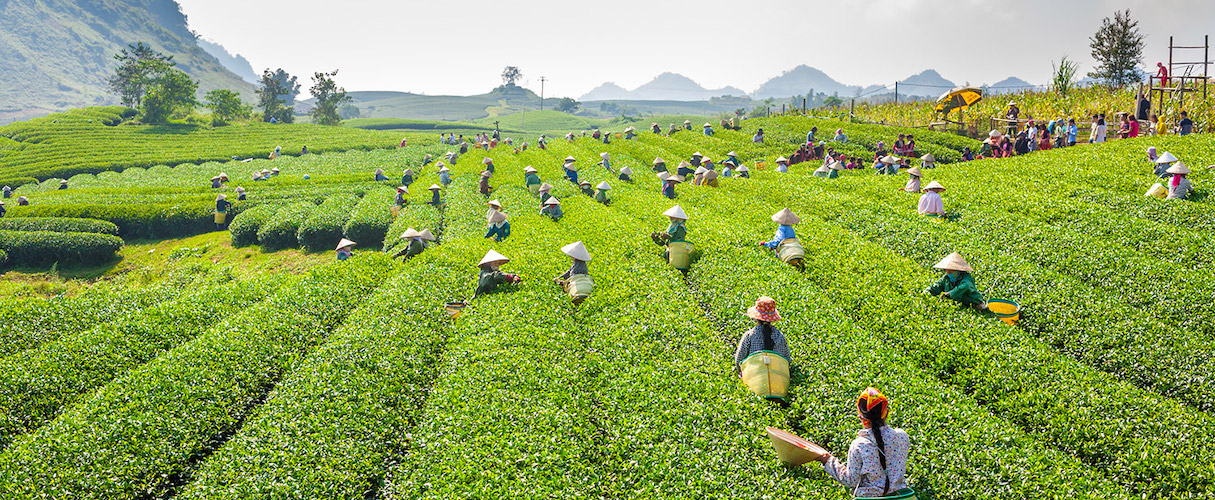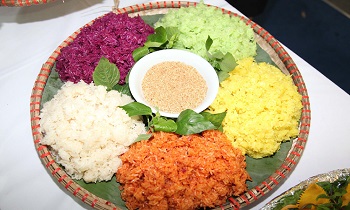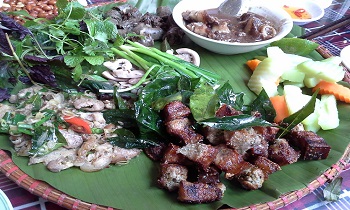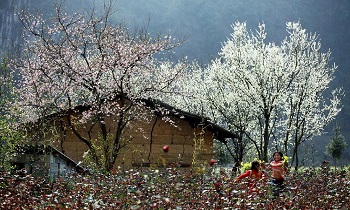Located 320km to the northwest of Hanoi, Son La province is often known as an overnight stop on the way to Dien Bien Phu province
Overview
Son La is well-known for the Former Prison and Museum that preserve revolutionary remains and exhibits precious objects proving historical and cultural traditions of the 12 local ethnic groups. Stretching out 150m long, Tham Toong Cave is a Nature Wonder. Along the walls inside the cave, there are various stalactites and stalagmites in different forms. Hin ethnic minority hamlet is marked by the traditions and culture of the Thai people. Tourists enjoy drinking Ruou Can and watching Xoe dance by Thai women. In a 2nd lunar month, when Mountain Ebony flower begins to blossom, covering the mountains in white, Thai ethnic group held Flower Festival. Boys and girls to the festival to celebrate the spring spiritual and entertain themselves by singing, playing Khen flute, dancing Xoe.
.jpg)
Son La
What to do in Son La
Son Moc Huong Cave
Mother Nature gives Moc Chau a naturally giant cave called Son Moc Huong (the scent of mountain trees) with beautiful stalactites and home to a lot of bats. Moc Huong cave or Bat cave is considered as the best cave in the NorthWest region.
From Moc Chau town, the cave is only a few minutes driving towards Son La City. The cave is just 150m away from the No.6 National Road. It faces a big and spectacular valley, on which stand 7 small gem-like mountains.
It is believed that once upon a time, there was a giant dragon flying toward the East Sea. When crossing Son La, it was amazed by the spectacular terrain, warm weather, and the peaceful scenery of this land. The dragon decided to settle down in the valley. When the dragon died, he left his 7 gems in the valley. The mouth of the dragon, which is also the mouth of Son Moc Huong Cave, turns to the South to watch out the precious gems. Nowadays, according to local people, the mountains turn white in the early morning, blue at noon, pink in the afternoon, and purple at sunset. There is no better way than testifying the truth by coming there yourself and watching the lights and color performance!
Mong village
Mong village is not only an eco-tourist but also a cultural symbol in Hua La, Son La. Located in Moc Chau plateau, Mong village attracts by the charm of mountains, green forest, and the magnificent river.
After their arrival at the village, tourists will immediately notice the unique scenery of spectacular mountains and rivers. The mountains of different sizes form a stunning range that resembles a dragon embracing the Nam La River.
mountains are covered in the green of Coffee trees, pine trees, plum trees, apricot trees, and bamboos. The village is also surrounded by primitive forests full of rare and colorful orchid flowers. When it comes to Spring, apricot flowers, plum flowers, and Mountain Monety flowers show off their beauty together, competing with one another create the picture of a forest. The village will turn out tranquil and gloomy in the winter. In fact, winter is Vong Gai flowers time, it's time to bloom, full-filled the forest with a bright-red color. Feeling the winter air while indulging yourself in the hot spring tub and looking down the red stilt houses, witnessing Vong Gai flowers will definitely be something that you remember forever.
In addition, there is a natural hot spring called Bó Nặm Ún. It’s good for medical treatment. The village consists of 106 households of Thai minority and villagers live mainly on brocade-weaving forgery, pottery… The traditional cultural values of the Thai ethnic group as costumes, jewelry, cuisine, festivals, folk dances, and songs ... still kept intact.
Dai Yem waterfall
If you visit Moc Chau town of Son La province, in Vietnam, you will have opportunities to watch the magic beauty which nature grants this area. Dai Yem waterfall also called "Ban Vat" by local people is a historical landscape. It is located close to the inhabitant of Thai people in Muon Sang land. The Vat spring would fill the waterfall all year round. The waterfall has only one line from the height of 50m. The trees in the top of the waterfall are plentiful to create the grandiosity for landscape.
.jpg)
Son La
Trying Thai specialties in Son La
Nom da Trau (buffalo skin salad)
In the delta, buffalo skin is used only to make drum faces because it was hard and thick, but Thai housewives knew how to turn it into a culinary specialty. The process to make the dish was complicated, but worth the effort.
First of all the leather is held over a fire to burn all the hair off. Then it outer black skin is scraped until it turns light and clean. The skin is boiled for an hour before soaking in cold water for another hour to ensure it becomes crispy.
The most difficult part is cutting the skin. It takes a sharp knife and skill, and hours to slice off into thin pieces and soak them in warm water mixed with lemon juice that makes it soft and fragrant. After that, the slices are soaked for an hour with special spices such as Tram Trang (Canarium), garlic, water from fermented bamboo Mac Khen nuts (a special fruit used to make) before mixing fresh Rau Don (forest vegetable) and banana inflorescence and covering it with fried nuts.
Dishes made from Bauhinia flowers
One of the favorite dishes of the Thai is Bauhinia flower soup that's mixture with bamboo shoots with broth made from buffalo bones. The flowers are collected early in the morning and left dry, the bamboo shoots are chopped into threads, then sticky rice is ground into flour. The buffalo bones are boiled in water to produce a kind of broth, then seasoning is added as well as bamboo shoots, and rice flour. When the soup is cooked, Bauhinia flowers and green onions are added to produce aroma.




